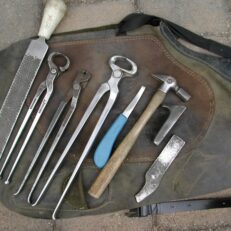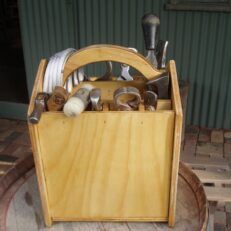The more I travel to assist horse owners from one end of this country to the other, the more convinced I become that there is a huge gap in the system of our horse owner education, in relation to the horse’s hoof.
Children attending pony clubs are given tuition in hoof inspection and basic care and attention of the hoof, and one would assume they carry this knowledge onto adulthood, but what about the adults who venture into the horse world for the first time?
It is your responsibility if you own or ride or care for a horse, to seek the how-to knowledge about hoof care and maintenance. Far too many horses suffer needlessly after simple mishaps such as springing a shoe or losing the odd nails while waiting for the farrier to arrive.
This situation can easily be helped if the owner just has a basic set of hoof care hand tools, and if they learn to take off a bent or loose shoe or replace that missing nail just to avoid problems until help arrives.
Horse owners should all learn to pick up and hold the leg of the horse anyhow, so why not practise holding it as the farrier does, then you will have the freedom to use both hands and with a set of basic tools you will be able to perform emergency care when your horse really needs it. As a farrier I can recall many occasions over the years when long term hoof problems could have been avoided if the horse owner had just been able to stabilise the shoe until I arrived.
Horse owners should be able to check the digital pulse of the horse if the horse displays lameness or if they suspect there is trauma in the hoof. Place the thumb and forefinger either side of the tendon at the bottom of the fetlock joint. There is no need to know what the ‘normal’ pulse is – simply compare to the other leg. Any elevated pulse indicates a problem in the hoof. It is worthwhile noting that if the horse displays lameness but there is no elevated digital pulse, then the problem is not in the hoof, so look to the hips, back, neck etc.
There are many books available which explain the procedure involved in hoof care and maintenance, however as you will soon find out this is a ‘doing’ kind of job; you must be prepared to get down and get your hands dirty, and if you can only manage to bend over like the farrier for a minute or two, it is a start. Remember practice makes perfect, so just keep doing it often enough and eventually both you and your horse will become comfortable and you will get to like it.
A basic hoof maintenance tool kit should include the following items:
-
Hoof knife – for cleaning out the sole area of dirt etc.
-
Buffer – for un-clinching the nail.
-
Nail puller- for removing the faulty nail.
-
Shoe puller – for lifting off the shoe.
-
Hoof rasp – for smoothing off the rough edges of the hoof wall.
-
Farrier’s hammer of medium weight – for driving nails.
-
Clinching block – for holding under the end of the nail while it is being tensioned with the hammer.
-
Farrier’s leather apron or chaps – for protection of your own legs and jeans.
All this is usually sold in a leather roll with pockets to keep each tool separate and in good order and condition. Consult with your own farrier if possible; he should be able to help you with any questions regarding your special needs and together you will be able to better care for your horse.


